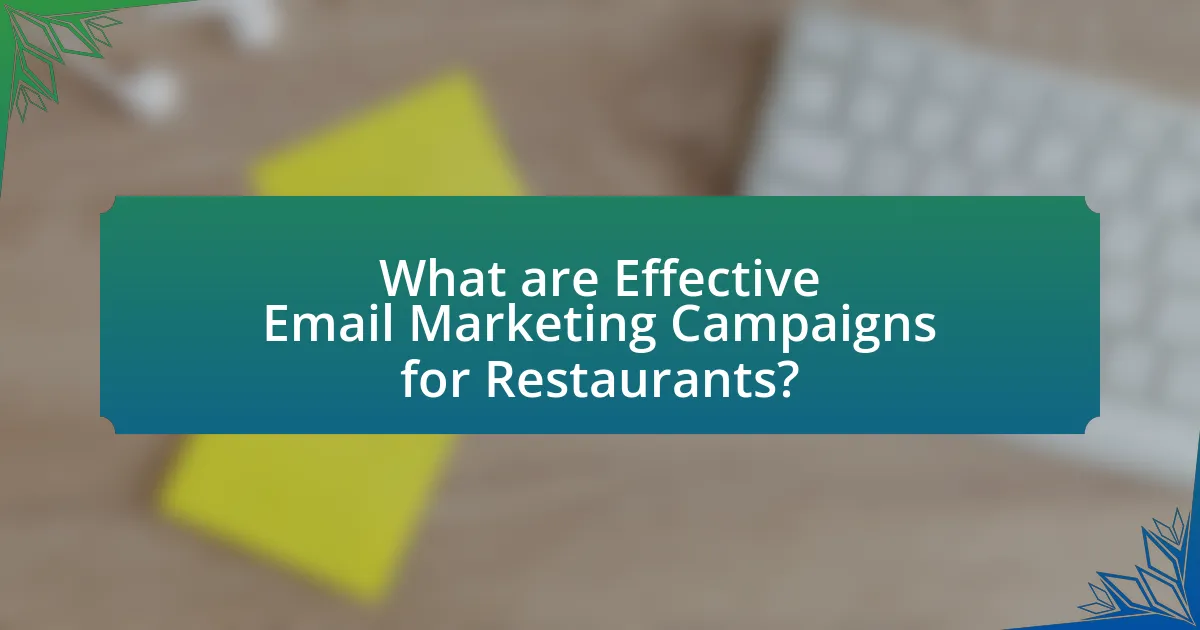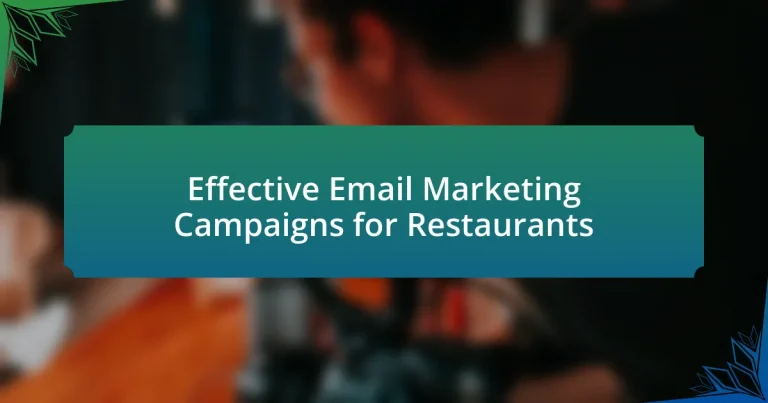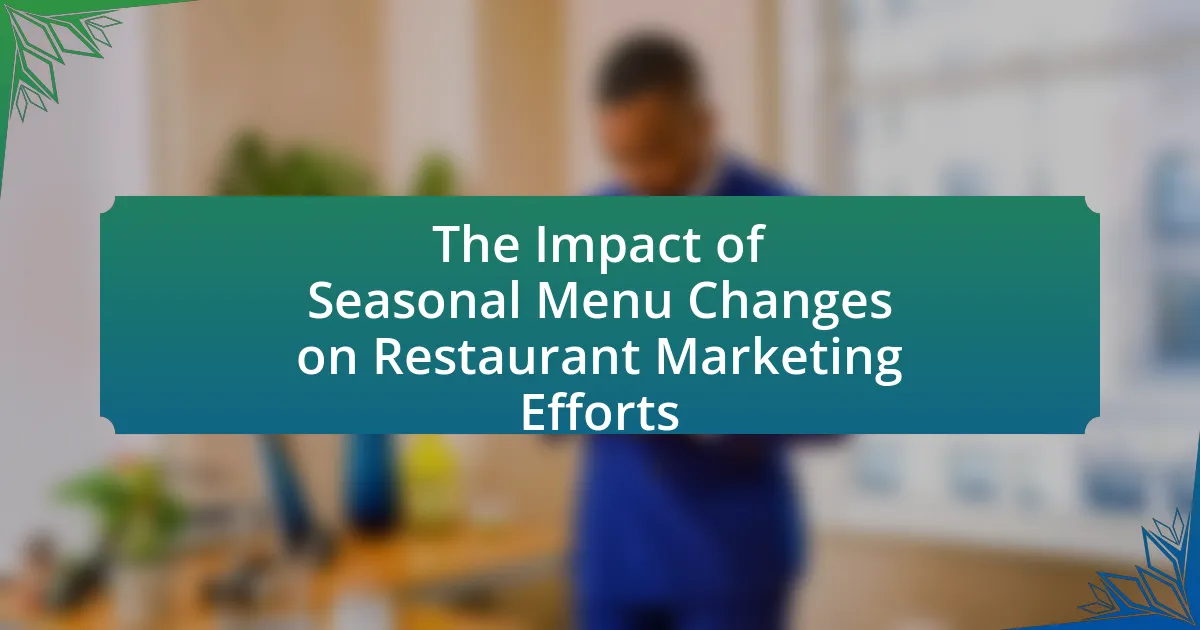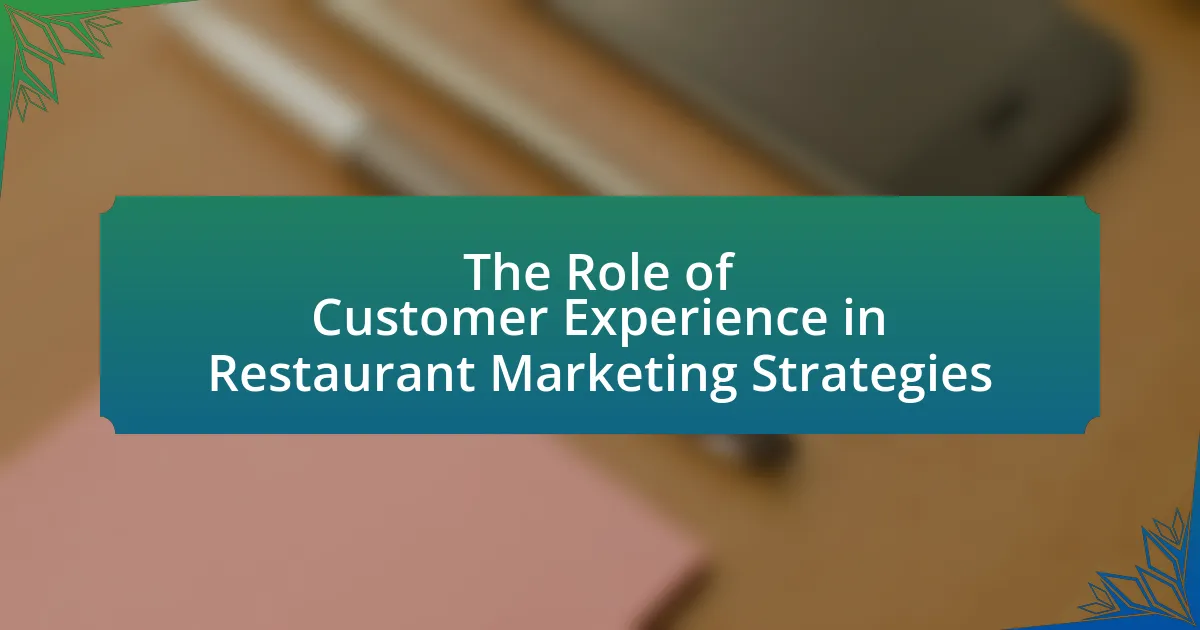Effective email marketing campaigns for restaurants focus on personalized promotions, loyalty programs, and event announcements to enhance customer engagement and drive sales. Key strategies include audience segmentation, compelling content, and mobile optimization, which collectively improve open and click-through rates. Restaurants face challenges such as high competition and customer disengagement, making it essential to avoid common pitfalls like irrelevant content and lack of personalization. By implementing best practices and measuring success through key performance indicators, restaurants can build and maintain a robust email subscriber list, ultimately increasing customer retention and revenue.

What are Effective Email Marketing Campaigns for Restaurants?
Effective email marketing campaigns for restaurants include personalized promotions, loyalty programs, and event announcements. Personalized promotions, such as tailored discounts based on customer preferences, can increase engagement; studies show that personalized emails have a 29% higher open rate. Loyalty programs incentivize repeat visits by offering rewards for frequent diners, which can boost customer retention by up to 20%. Additionally, announcing special events or new menu items through email can drive traffic, as 60% of consumers report being influenced by email marketing when deciding where to dine. These strategies collectively enhance customer relationships and drive sales for restaurants.
How do email marketing campaigns specifically benefit restaurants?
Email marketing campaigns specifically benefit restaurants by enhancing customer engagement and driving repeat business. These campaigns allow restaurants to communicate directly with their customers, promoting special offers, new menu items, and events, which can lead to increased foot traffic and sales. According to a study by the Direct Marketing Association, email marketing has an average return on investment of $42 for every dollar spent, highlighting its effectiveness in reaching and retaining customers. Additionally, targeted email campaigns can segment audiences based on preferences and behaviors, ensuring that messages resonate with specific customer groups, thereby increasing the likelihood of conversion.
What unique challenges do restaurants face in email marketing?
Restaurants face unique challenges in email marketing primarily due to high competition and customer disengagement. The restaurant industry is saturated, making it difficult for individual establishments to stand out in crowded inboxes. Additionally, many consumers receive numerous promotional emails daily, leading to low open and click-through rates. According to a study by Mailchimp, the average open rate for restaurant emails is around 20.5%, which is lower than other industries. Furthermore, restaurants often struggle with maintaining an updated and segmented email list, as customer preferences can change rapidly. This lack of segmentation can result in irrelevant content being sent to customers, further diminishing engagement.
How can email marketing enhance customer engagement for restaurants?
Email marketing enhances customer engagement for restaurants by enabling direct communication with patrons, fostering loyalty, and promoting special offers. Through targeted campaigns, restaurants can send personalized messages that resonate with customers’ preferences, increasing the likelihood of repeat visits. According to a study by the Direct Marketing Association, email marketing has an average return on investment of $42 for every dollar spent, demonstrating its effectiveness in driving customer engagement. Additionally, segmented email lists allow restaurants to tailor content based on customer behavior, further enhancing engagement and satisfaction.
What key elements make up a successful email marketing campaign for restaurants?
A successful email marketing campaign for restaurants includes targeted audience segmentation, engaging content, compelling subject lines, and clear calls to action. Targeted audience segmentation allows restaurants to tailor messages to specific customer preferences, increasing relevance and engagement. Engaging content, such as promotions, menu updates, and events, keeps subscribers interested and encourages them to visit. Compelling subject lines improve open rates; studies show that 47% of email recipients decide whether to open an email based solely on the subject line. Clear calls to action guide customers on the next steps, whether it’s making a reservation or redeeming a coupon, ultimately driving conversions.
What types of content should be included in restaurant emails?
Restaurant emails should include promotional offers, menu updates, event announcements, customer testimonials, and personalized messages. Promotional offers attract customers by providing discounts or special deals, while menu updates inform subscribers about new dishes or seasonal items. Event announcements keep customers engaged with upcoming happenings, such as live music or themed nights. Customer testimonials build trust and credibility, showcasing positive dining experiences. Personalized messages enhance customer relationships by addressing recipients by name and tailoring content to their preferences. These elements collectively drive engagement and encourage repeat visits, which is essential for successful email marketing campaigns in the restaurant industry.
How important is email design and layout for restaurants?
Email design and layout are crucial for restaurants as they significantly impact customer engagement and conversion rates. A well-structured email can enhance readability, making it easier for recipients to absorb information about promotions, menu updates, or events. According to a study by Campaign Monitor, emails with a mobile-responsive design can increase click-through rates by up to 15%. Additionally, visually appealing layouts that incorporate high-quality images of food can stimulate appetite and encourage customers to visit the restaurant. Therefore, effective email design and layout are essential for maximizing the effectiveness of marketing campaigns in the restaurant industry.
What strategies can restaurants implement for effective email marketing?
Restaurants can implement several strategies for effective email marketing, including segmenting their audience, personalizing content, and optimizing for mobile devices. Segmenting the audience allows restaurants to tailor messages based on customer preferences and behaviors, which can lead to higher engagement rates. Personalization, such as addressing customers by name and recommending dishes based on past orders, enhances the customer experience and fosters loyalty. Additionally, optimizing emails for mobile devices is crucial, as over 50% of emails are opened on smartphones, ensuring that content is easily accessible and visually appealing on smaller screens. These strategies collectively contribute to improved open rates, click-through rates, and overall customer retention in email marketing campaigns.
How can segmentation improve email marketing results for restaurants?
Segmentation can significantly improve email marketing results for restaurants by allowing targeted messaging that resonates with specific customer groups. By dividing the customer base into segments based on factors such as dining preferences, frequency of visits, and demographics, restaurants can tailor their email content to meet the unique needs and interests of each group. For instance, a study by Mailchimp found that segmented email campaigns have an open rate that is 14.32% higher than non-segmented campaigns. This targeted approach not only increases engagement but also enhances customer loyalty and drives repeat visits, ultimately leading to higher revenue for the restaurant.
What role does personalization play in restaurant email campaigns?
Personalization significantly enhances the effectiveness of restaurant email campaigns by increasing engagement and conversion rates. When emails are tailored to individual preferences, such as past dining experiences or specific dietary choices, recipients are more likely to open, read, and act on the content. Research indicates that personalized emails can lead to a 29% higher open rate and a 41% higher click-through rate compared to non-personalized emails. This demonstrates that personalization not only captures attention but also drives customer loyalty and repeat visits, ultimately boosting revenue for restaurants.
How can restaurants measure the success of their email marketing campaigns?
Restaurants can measure the success of their email marketing campaigns through key performance indicators (KPIs) such as open rates, click-through rates (CTR), conversion rates, and return on investment (ROI). Open rates indicate the percentage of recipients who opened the email, providing insight into the effectiveness of subject lines and timing. Click-through rates measure how many recipients clicked on links within the email, reflecting engagement levels. Conversion rates track the percentage of recipients who completed a desired action, such as making a reservation or placing an order, which directly correlates to campaign effectiveness. Finally, ROI assesses the financial return generated from the campaign relative to its cost, allowing restaurants to evaluate overall profitability. According to a study by Campaign Monitor, the average open rate for restaurant emails is around 20%, while the average CTR is approximately 2.5%, providing benchmarks for restaurants to compare their performance against industry standards.
What key performance indicators (KPIs) should restaurants track?
Restaurants should track key performance indicators (KPIs) such as sales revenue, customer acquisition cost, customer retention rate, average order value, and table turnover rate. Sales revenue provides insight into overall financial performance, while customer acquisition cost helps evaluate marketing efficiency. Customer retention rate indicates loyalty and satisfaction, and average order value measures the effectiveness of upselling strategies. Table turnover rate assesses operational efficiency during service hours. Tracking these KPIs enables restaurants to make data-driven decisions that enhance profitability and customer experience.
How can A/B testing be utilized in restaurant email marketing?
A/B testing can be utilized in restaurant email marketing by comparing two versions of an email to determine which one performs better in terms of open rates, click-through rates, and conversions. For instance, a restaurant can test different subject lines, email layouts, or call-to-action buttons to see which variation resonates more with their audience. Research indicates that A/B testing can lead to a 49% increase in email engagement when optimized correctly, as it allows marketers to make data-driven decisions based on actual customer behavior rather than assumptions. This method enhances the effectiveness of email campaigns by ensuring that the content aligns with customer preferences, ultimately driving higher customer engagement and increased reservations or sales.
What are common pitfalls to avoid in restaurant email marketing?
Common pitfalls to avoid in restaurant email marketing include neglecting audience segmentation, failing to personalize content, and not optimizing for mobile devices. Audience segmentation is crucial because sending generic emails can lead to lower engagement rates; studies show that segmented campaigns can result in a 760% increase in revenue. Personalization enhances customer experience, as emails with personalized subject lines have a 26% higher open rate. Additionally, with over 50% of emails opened on mobile devices, not optimizing emails for mobile can result in poor user experience and decreased click-through rates.
How can restaurants ensure compliance with email marketing regulations?
Restaurants can ensure compliance with email marketing regulations by obtaining explicit consent from recipients before sending marketing emails. This involves implementing a clear opt-in process where customers willingly provide their email addresses, which is a requirement under laws such as the CAN-SPAM Act in the United States and the General Data Protection Regulation (GDPR) in Europe. Additionally, restaurants must provide a straightforward way for recipients to unsubscribe from future emails, ensuring that the unsubscribe process is easy to find and execute. Regularly reviewing and updating email marketing practices to align with current regulations is also essential for maintaining compliance.
What mistakes should restaurants avoid to maintain subscriber engagement?
Restaurants should avoid sending irrelevant content to maintain subscriber engagement. Irrelevant content can lead to decreased open rates and increased unsubscribes, as subscribers are more likely to disengage if the emails do not align with their interests or needs. For instance, a study by HubSpot found that 78% of consumers unsubscribe from emails due to irrelevant content. Additionally, restaurants should refrain from overloading subscribers with emails, as excessive communication can overwhelm recipients and result in disengagement. According to a survey by Mailchimp, emails sent too frequently can lead to a 50% increase in unsubscribe rates. By focusing on relevant, targeted content and maintaining an appropriate frequency, restaurants can enhance subscriber engagement effectively.
What are best practices for creating effective email marketing campaigns for restaurants?
To create effective email marketing campaigns for restaurants, focus on segmenting your audience, personalizing content, and optimizing for mobile devices. Segmenting allows restaurants to tailor messages based on customer preferences, increasing engagement rates; for instance, targeted emails can lead to a 760% increase in revenue, according to a study by Campaign Monitor. Personalization enhances customer experience by addressing recipients by name and recommending dishes based on past orders, which can significantly boost open and click-through rates. Additionally, optimizing emails for mobile ensures that over 50% of users who check emails on their phones have a seamless experience, as reported by Litmus. Implementing these best practices can lead to higher customer retention and increased sales for restaurants.
How can restaurants build and maintain their email subscriber list?
Restaurants can build and maintain their email subscriber list by offering incentives such as discounts or exclusive promotions for signing up. This strategy encourages potential customers to provide their email addresses, increasing the subscriber base. Additionally, restaurants should utilize sign-up forms on their websites and social media platforms to capture interested individuals. Regularly engaging with subscribers through valuable content, such as newsletters featuring menu updates or special events, helps maintain interest and reduces unsubscribe rates. According to a study by HubSpot, personalized email marketing can lead to a 29% higher open rate, demonstrating the effectiveness of tailored communication in retaining subscribers.
What tips can enhance the effectiveness of restaurant email campaigns?
To enhance the effectiveness of restaurant email campaigns, focus on personalization, segmentation, and compelling content. Personalization increases engagement; emails that include the recipient’s name in the subject line can improve open rates by 26%. Segmentation allows targeted messaging based on customer preferences and behaviors, leading to higher conversion rates. Compelling content, such as exclusive offers or enticing visuals of menu items, can drive customer action. According to a study by Campaign Monitor, personalized emails deliver six times higher transaction rates, proving that these strategies significantly boost campaign performance.




